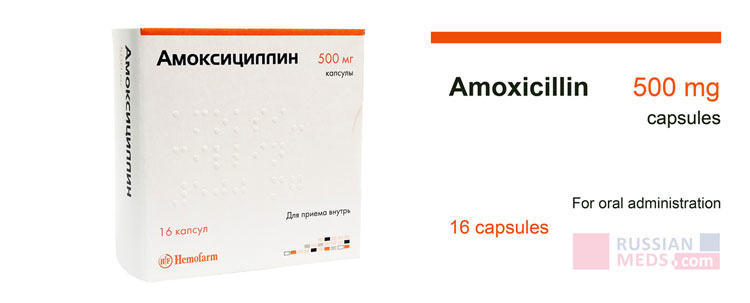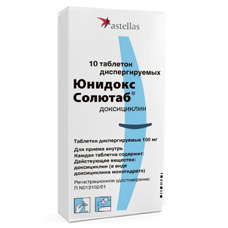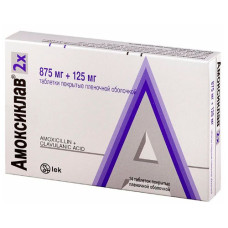
Amoxicillin capsules
Amoxicillin is a semi-synthetic broad-spectrum antibiotic of the penicillin group for the treatment of bacterial infections, including a middle ear infection, tonsillitis, pneumonia, skin infections, urinary tract infections.
Pharmachologic effect:
broad spectrum antibacterial, bactericidal.Pharmacodynamics:
Amoxicillin is similar to penicillin in its bactericidal action against sensitive bacteria at the stage of active reproduction. It acts by inhibiting cell wall biosynthesis, resulting in the death of bacteria.
Amoxicillin is active against most of the bacterial isolates listed below:
Gram-positive microorganisms: Enterococcus faecalis, Staphylococcus spp., Streptococcus pneumoniae, Streptococcus spp. (alpha and beta hemolytic isolates).
Gram-negative microorganisms: Escherichia coli, Haemophilus influenzae, Helicobacter pylori, Proteus mirabilis.
Pharmacokinetics:
After oral administration, amoxicillin is rapidly absorbed and does not break down in the acidic environment of the stomach. The effect of food intake on the absorption of amoxicillin is not well understood, the use of amoxicillin at doses of 400 and 875 mg has been studied only at the beginning of a light meal.
Oral administration of amoxicillin in the form of capsules at doses of 250 and 500 mg leads to an average Cmax in blood plasma 1-2 hours after administration in the range from 3.5 to 5 and 5.5 to 7.5 μg / ml, respectively.
Taking amoxicillin in the form of a suspension for oral administration at doses of 125 and 250 mg / 5 ml leads to an average Cmax in blood plasma in 1-2 hours after administration in the range from 1.5 to 3 and from 3.5 to 5mcg / ml, respectively .
Amoxicillin easily penetrates into most tissues and body fluids, with the exception of the brain and cerebrospinal fluid, except in cases of inflammation of the meninges. In serum, amoxicillin is approximately 20% bound to proteins.
T1 / 2 of amoxicillin is 61.3 minutes. Approximately 60% of an orally administered dose of amoxicillin is excreted in the urine within 6-8 hours. Serum concentrations are detectable up to 8 hours after an oral dose of amoxicillin. Since most of the administered dose of amoxicillin is excreted in the urine unchanged, its excretion may be slowed down with the simultaneous use of probenecid.
Indications:
- infections of the ENT organs (ear, nose and throat) caused by susceptible (only beta-lactamase-negative) isolates of Streptococcus species (only alpha and beta hemolytic isolates), Streptococcus pneumoniae, Staphylococcus spp. or Haemophilus influenzae;
- urinary tract infections caused by sensitive (only beta-lactamase-negative) isolates of Escherichia coli, Proteus mirabilis or Enterococcus faecalis;
- infections of the skin and subcutaneous tissue caused by sensitive (beta-lactamase-negative only) isolates of Streptococcus spp. (alpha and beta hemolytic isolates only), Staphylococcus spp. or E. coli;
- lower respiratory tract infections caused by susceptible (beta-lactamase-negative only) isolates of Streptococcus spp. (only alpha and beta hemolytic isolates), S. pneumoniae, Staphylococcus spp. or H. influenzae;
- H. pylori infection (as triple therapy with clarithromycin and lansoprazole or dual therapy with lansoprazole in patients with H. pylori infection and duodenal ulcer (active or history of duodenal ulcer within 1 year) with diagnosed allergy or intolerance to clarithromycin, or who have been diagnosed or suspected to be resistant to clarithromycin).
Contraindications:
Serious hypersensitivity reaction (eg, anaphylaxis or Stevens-Johnson syndrome) to amoxicillin or other beta-lactam antibacterial drugs (eg, penicillins and cephalosporins).
Pregnancy and breast-feeding:
Category of action on the fetus according to the FDA - B.
It has been proven that penicillins are excreted in human milk. The use of amoxicillin by women during breastfeeding can lead to sensitization of infants. Caution should be exercised when prescribing amoxicillin to lactating women.
Side effects:
The most common adverse reactions (>1%) observed in clinical trials of amoxicillin (capsules, tablets, or oral suspension) were diarrhea, skin rash, vomiting, and nausea.
Triple therapy: The most common adverse reactions in patients treated with triple therapy (amoxicillin + clarithromycin + lansoprazole) were diarrhea (7%), headache (6%) and taste perversion (5%).
Dual Therapy: The most common adverse reactions in patients treated with amoxicillin + lansoprazole dual therapy were diarrhea (8%) and headache (7%).
Interaction:
Probenecid reduces tubular secretion of amoxicillin by the kidneys. The simultaneous use of amoxicillin and probenecid can lead to an increase in the concentration of amoxicillin in the blood and a prolongation of its action.
Abnormal prolongation of PT (increased INR) has been reported in patients taking amoxicillin and oral anticoagulants. With the simultaneous appointment of anticoagulants, appropriate monitoring should be carried out. To maintain the desired level of anticoagulation, dose adjustment of oral anticoagulants may be required.
The simultaneous use of allopurinol and amoxicillin increases the incidence of skin rash in patients receiving both drugs, compared with patients receiving only amoxicillin. It is not known whether this phenomenon is associated with the simultaneous use of allopurinol or with the presence of hyperuricemia in these patients.
Amoxicillin can affect the intestinal microflora, which leads to a decrease in estrogen reabsorption and a decrease in the effectiveness of combined oral estrogen-/progesterone-containing contraceptives.
Chloramphenicol, macrolides, sulfonamides and tetracyclines may interfere with the bactericidal action of penicillin. This interaction has been observed in vitro, but its clinical significance is not well documented.
High concentrations of ampicillin in the urine can lead to false positive reactions when determining the content of glucose in urine using CLINITEST, Benedict's solution or Fehling's solution. Since this effect can also be observed with the use of amoxicillin, it is recommended to use glucose tests based on enzymatic reactions of glucose oxidase (for example, CLINISTIX).
After the administration of ampicillin or amoxicillin to pregnant women, a transient decrease in plasma concentrations of total conjugated estriol, estriol glucuronide, conjugated estrone and estradiol was noted.
Dosing and Administration:
The duration of therapy is determined by the doctor and is usually 7-10 days (at least 2-3 days after the symptoms disappear).
For further details of dosing regiment please see table in the PDF leaflet.
Amoxicillin capsules
in Cyrillic : Амоксициллин
SUBSTANCE
Amoxicillin
DOSAGE FORM
capsules



